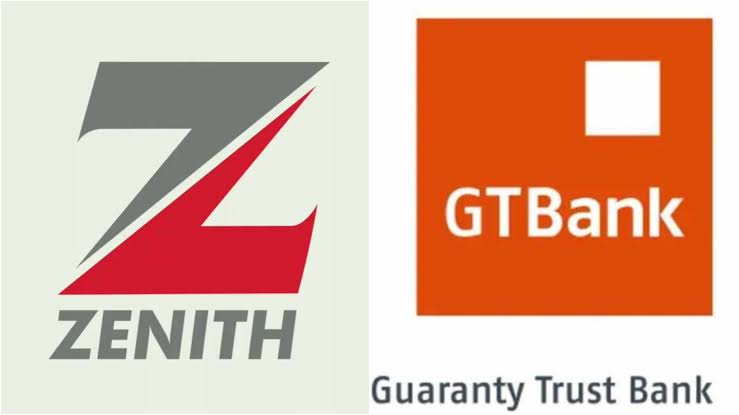
Nigeria’s tier-one banks — GTCO (Guaranty Trust Holding Company Plc) and Zenith Bank Plc — continue their long-standing rivalry for investor confidence and market dominance. Their half-year 2025 results reveal both strengths and weaknesses, shaped by contrasting strategies in growth, risk management, and balance sheet structure.
In terms of stock performance, Zenith Bank’s share price has climbed impressively from ₦18.63 in 2020 to about ₦68 by October 2025, reflecting a compound annual growth rate of roughly 38 percent. Year-to-date, its stock is up nearly 50 percent. GTCO, on the other hand, has seen its share price rise from ₦29.20 in 2020 to ₦94.00 within the same period, delivering a CAGR of about 28 percent and a 2025 year-to-date gain of 64 percent. While GTCO enjoys stronger investor sentiment at the moment, Zenith’s consistent long-term performance underscores its resilience.
Over the past five years, GTCO’s profit after tax has grown at around 50 percent CAGR, slightly ahead of Zenith’s 45 percent. However, in absolute terms, Zenith still leads with cumulative profits of about ₦2.41 trillion compared to GTCO’s ₦2.10 trillion. In the first half of 2025, Zenith’s pre-tax profit declined by 13.9 percent year-on-year to ₦625.6 billion, mainly due to a sharp rise in impairment provisions, which nearly doubled from ₦415 billion to ₦761 billion. GTCO’s pre-tax profit also dropped by about 40 percent year-on-year to ₦600.9 billion, largely because of a steep decline in foreign exchange gains — from over ₦600 billion in 2024 to just ₦26 billion in H1 2025. Zenith’s higher provisioning reflects a more conservative credit approach, while GTCO’s reliance on FX gains exposes it to volatility.
When it comes to core banking strength, Zenith generated about ₦1.84 trillion in interest income, with most of it coming from loans and treasury activities, while GTCO recorded ₦812 billion in interest income, boosted by its investment securities. Zenith’s net interest income stood at about ₦1.36 trillion, while GTCO posted ₦632 billion, showing a 28 percent year-on-year increase. Zenith continues to dominate in core banking income, benefiting from its larger lending base and treasury yield leverage.
On the balance sheet side, GTCO reported total assets of ₦16.69 trillion, deposits of ₦11.88 trillion, and loans of ₦3.36 trillion, resulting in a loan-to-deposit ratio of around 28 percent. Zenith, meanwhile, maintained total assets of ₦30.99 trillion, deposits of ₦23.48 trillion, and loans of ₦9.60 trillion, giving it a stronger 41 percent loan-to-deposit ratio. This shows that Zenith’s larger scale and more aggressive loan deployment provide greater revenue potential, while GTCO’s leaner structure favors stability but limits its growth room.
In shareholder returns, GTCO declared an interim dividend of ₦1.00 per share for 2025, maintaining a five-year dividend growth rate of about 29 percent and an average payout ratio of 38 percent. Zenith declared ₦1.25 per share for the same period, with a five-year growth rate of about 20 percent and a 33 percent payout ratio. GTCO’s dividend policy appears more growth-driven, while Zenith provides slightly higher immediate yield.
From a valuation standpoint, Zenith trades at a price-to-earnings ratio of about 2.48 times and a price-to-book ratio of 0.62 times, indicating it’s still trading below book value. GTCO’s valuation is higher, with a P/E ratio of 5.29 times and a P/B ratio of 1.09 times, showing it trades at a premium to its book value. This makes Zenith look undervalued relative to its fundamentals, while GTCO is priced higher due to stronger market sentiment.
In summary, Zenith Bank demonstrates strength through scale, conservative risk management, and robust core earnings, making it ideal for investors seeking stability and steady income. GTCO, on the other hand, appeals to those pursuing growth opportunities, with a strong brand and attractive dividend trajectory, though it faces higher exposure to FX-related volatility. Zenith may be the safer anchor in the current market, while GTCO remains the high-performance growth pick.
